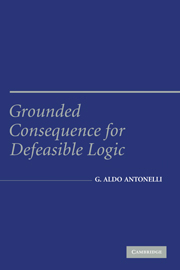2 - Defeasible Inheritance over Cyclic Networks
Published online by Cambridge University Press: 18 July 2009
Summary
BACKGROUND AND MOTIVATION
Defeasible inheritance networks were originally developed to gain a sound mathematical understanding of the way inheritance systems store, gain access to, and manipulate taxonomic information with exceptions (a survey can be found in Thomason, 1992). An inheritance network can be identified with a collection of signed links (positive or negative) over a set of nodes. Such links are of the form n1 → n2 or n1 ↛ n2, respectively, where n1 and n2 are nodes in the net. Such nodes are labeled by lexical items referring to categories of individuals. It is convenient to identify nodes with their labels.When the network is to be interpreted defeasibly, a link n1 → n2 represents the fact that objects of category n1 tend to be of category n2, whereas a link of the form n1 ↛ n2 represents the fact that objects of category n1 tend not to be of category n2. A path over a net Γ is a sequence of links from Γ, at most the last one of which is allowed to be negative. So both n1 → n2 → n3 and n1 → n2 ↛ n3 are paths, whereas n1 ↛ n2 → n3 is not. A path is positive or negative according to whether its last link is positive or negative.
Information
- Type
- Chapter
- Information
- Grounded Consequence for Defeasible Logic , pp. 29 - 58Publisher: Cambridge University PressPrint publication year: 2005
